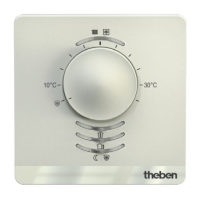Appendix
RAMSES 718 P / RAMSES 718 S 95
6.5.3 Response of the PI controller
In contrast to the pure P controller, the PI controller functions dynamically.
With this type of controller, the actuating value remains unchanged, even at a constant
deviation.
At the first moment, the PI controller sends the same actuating value as the P controller.
However, this will be increased further the longer the set point will not be reached.
This increase is time-controlled over the so-called integration time.
During this calculation method, the actuating value will not be changed anymore when the set
point equals the actual value.
In our example, this results in the balance between feed and discharge.
A good control depends on the adjustment of bandwidth and integration time with the
room to be heated.
The bandwidth influences the increment of the actuating value change:
Large bandwidth = finer increments for the actuating value change.
The integration time influences the response time to temperature changes:
Long integration time = slow response.
Poor adjustment can result in either the set point being exceeded (overshoot), or the
controller taking too long to reach the set point.
The best results are generally achieved using the standard settings or with the settings via
installation type.
6.6 Continuous and switching control
A switching (2 point) control recognises only 2 statuses, On or Off.
A continuous control works with an actuating value between 0% and 100% and can thus
exactly dose the energy input. This provides a pleasant and precise degree of control.
Table 2: Overview of control functions

